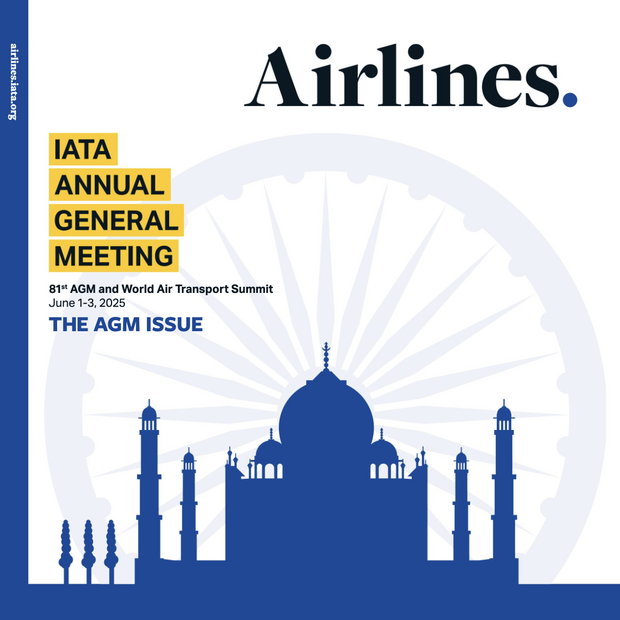
Translations:
国际航协:6月航空货运需求放缓 (pdf)
Le repli du fret aérien s’atténue en juin (pdf)
Contração do transporte aéreo de cargas diminui em junho (pdf)
Geneva - The International Air Transport Association (IATA) released data for June 2023 global air cargo markets showing the smallest year-over-year contraction in demand since February 2022.
Global demand, measured in cargo tonne-kilometers (CTKs), fell 3.4% in June compared to June 2022 (-3.7% for international operations). For the half year, demand slid 8.1% compared to the January-June period of 2022 (-8.7% for international operations). However, demand in June was only 2.4% below June 2019 levels (pre-pandemic).
Capacity, as measured by available cargo tonne-kilometers (ACTKs), rose 9.7% compared to June 2022, which was a slower rate compared to the double-digit growth recorded between March and May. This reflects strategic capacity adjustments airlines are making amid a weakened demand environment. Capacity for the first half of 2023 was up 9.9% compared to a year ago. Capacity is now 3.7% above June 2019 (pre-pandemic) levels.
Key factors influencing air cargo demand include:
- In June, both manufacturing output Purchasing Managers Index or PMI (49.2) and new export orders PMI (47.1) were below the critical threshold represented by the 50 mark, indicating a decline in global manufacturing production and exports.
- Global cross-border trade decreased by 2.4% year-over-year in May, reflecting the cooling demand environment and challenging macroeconomic conditions. The difference between the annual growth rates of air cargo and the global goods trade narrowed to -2.6 percentage points in May, representing the smallest gap since January 2022. However, the gap still suggests that air cargo continues to suffer more than container cargo from the slowdown in global trade.
“We remain hopeful that the difficult trading conditions for air cargo will moderate as inflation eases in major economies. This, in turn, could encourage the central banks to loosen the money supply, which could stimulate greater economic activity,” said Willie Walsh, IATA’s Director General.
Air cargo market in detail
| June 2023 (%year-on-year) | World Share *1 | CTK | ACTK | CLF (%-pt) *2 | CLF (level) *3 |
|---|---|---|---|---|---|
| Total Market | 100% | -3.4% | 9.7% | -5.8% | 43.2% |
| Africa | 2.0% | -2.8% | -3.7% | 0.4% | 44.6% |
| Asia Pacific | 32.4% | -3.6% | 24.4% | -13.6% | 46.8% |
| Europe | 21.8% | -2.8% | 4.4% | -3.5% | 47.6% |
| Latin America | 2.7% | 7.3% | 15.4% | -2.5% | 33.7% |
| Middle East | 13.0% | 0.5% | 11.1% | -4.7% | 44.6% |
| North America | 28.1% | -6.5% | 0.7% | -2.9% | 37.4% |
(*1) % of industry CTKs in 2022 (*2) Year-on-year change in load factor (*3) Load factor level
June Regional Performance
Asia-Pacific airlines saw their air cargo volumes decrease by 3.6% in June 2023 compared to the same month in 2022. This was also a decline compared to May (-2.5%), mainly owing to weak demand on within-Asia markets, although the Asia-North America trade lane saw improved performance. Available capacity in the region increased by 24.4% compared to June 2022. Looking at the first half of 2023, cargo demand was down 6.5% versus the year-ago period against a 27.0% rise in capacity.
North American carriers had a 6.5% decrease in total cargo volumes in June 2023 compared to the same month in 2022, marking the fourth consecutive month in which the region had the weakest performance. This was, however, an improvement compared to May (-8.6%). Europe-North America CTKs shrank by only 2.7% in June, following three months of double-digit contractions. Capacity increased 0.7% compared to June 2022. For the 2023 first half, cargo demand was down 10.5% compared to the 2022 first half, while capacity dipped 0.7%.
European carriers experienced a 2.8% decrease in cargo volumes in June 2023, compared to the same month in 2022. This was an improvement in performance compared to May (-6.6%), in part due to the aforementioned Europe-North America performance. Capacity increased 4.4% compared to June 2022. Cargo demand was down 10.2% for the first six months of 2023 compared to last year, as the half-year capacity rose 2.5%.
Middle Eastern carriers posted a 0.5% increase in cargo volumes in June 2023 versus a year ago. This was a strong turnaround from the 2.9% year-over-year decline registered in May. Capacity rose 11.1% for the month. Both Middle East-Asia and Middle East-Europe route areas saw annual growth. For the first half of the year, cargo demand was down 5.6% compared to a year ago, with an 11.2% hike in capacity.
Latin American carriers had strongest performance in June 2023, with a 7.3% increase in cargo volumes compared to June 2022. This was an improvement compared to May (+3.8%). Capacity in June was up 15.4% over the same month in 2022. For the 2023 first half, cargo demand was up 0.9% versus a year ago, while capacity climbed 18.0%.
African airlines posted a 2.8% decrease in demand compared to June 2022. This was a decline in performance compared to the previous month (-1.9%). Capacity in June was down 3.7% compared to the same month in 2022. For the first half of the year, cargo demand slowed by 4.4% while capacity climbed 1.6%.
> View June 2023 Air Cargo Market Analysis (pdf)
For more information, please contact:
Corporate Communications
Tel: +41 22 770 2967
Email: corpcomms@iata.org
Notes for Editors:
- IATA (International Air Transport Association) represents some 350 airlines comprising over 80% of global air traffic.
- You can follow us on X for announcements, policy positions, and other useful industry information.
- Fly Net Zero
- * Please note that as of January 2020 onwards, we have clarified the terminology of the Industry and Regional series from ‘Freight’ to ‘Cargo’, the corresponding metrics being FTK (changed to ‘CTK’), AFTK (changed to ‘ACTK’), and FLF (changed to ‘CLF’), in order to reflect that the series have been consisting of Cargo (Freight plus Mail) rather than Freight only. The data series themselves have not been changed.
- Explanation of measurement terms:
- CTK: cargo tonne-kilometers measures actual cargo traffic
- ACTK: available cargo tonne-kilometers measures available total cargo capacity
- CLF: cargo load factor is % of ACTKs used
- IATA statistics cover international and domestic scheduled air cargo for IATA member and non-member airlines.
- Total cargo traffic market share by region of carriers in terms of CTK is: Asia-Pacific 32.4%, Europe 21.8%, North America 28.1%, Middle East 13.0%, Latin America 2.7%, and Africa 2.0%.

